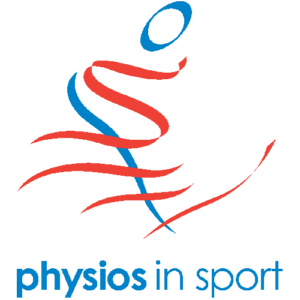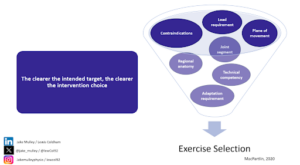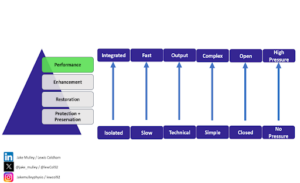A collaborative rehabilitation framework involving the dual-discipline support of physiotherapy and strength & conditioning (S&C). To assist the athlete’s journey from injury to performance.
Keywords: Exercise selection; rehabilitation programming; strength and conditioning

Introduction:
Part one of this blog series established factors involved in the working relationship of an S&C coach and physiotherapist when supporting an athlete’s return to performance (RTP), specifically in relation to the assessment and planning aspects of rehabilitation.
This is part two of this blog series which explores how S&C and physiotherapy practitioners effectively apply their collective skill sets, break down and analyse movement tasks, applying exercise prescription knowledge to achieve the desired outcome.

Figure 1: Prioritise and programme (Dyer, C., 2020) (2)
Prioritise and programme – performance task breakdown:
The ‘prioritise and programme’ aspect of this process requires robust foundation knowledge of the task the athlete is returning to, breaking this down to its constituent parts anatomically and physiologically.
S&C coaches and physiotherapists are well placed in problem solving this collaboratively. By reverse engineering the task it is possible to jointly agree on the areas of adaptation required. This can be done by firstly looking at the performance demand and then the performance actions. Subsequently, it is important to establish the biomechanical factors involved in completing the performance task and therefore identify the adaptation requirements to achieve this.

Figure 2: Performance task breakdown (Dorn et al., 2012) (1), (Lenhart et al., 2014) (4)
Prioritise and programme – achieving the targeted adaptation:
A lack of clarity on the specific physical outcomes results in programmes that may be inappropriately aligned to the needs of the athlete. Examples include a lack of preparation for exercise programme progressions and an overly general and vague programme with not enough specific content to drive an adaptive response physically. Recognising what type of adaptation is needed to bridge the gap between the athletes current anatomical and physiological capabilities and the performance task requirements, can help effectively prioritise and programme the rehabilitation. S&C and physiotherapy clinicians should jointly discuss what to target.

Figure 3: Example areas for targeted adaptation (Wolf, A., 2020) (6)
Prioritise and programme – exercise selection:
There are endless choices of exercises, drills and activities that can be used during rehabilitation to obtain adaptive responses to the human body. Once clarity is gained regarding the adaptive priorities required, the selection of exercises can become clearer through a ‘funnelling’ process. This allows S&C and physiotherapy practitioners to determine the appropriateness and importance of an exercise within a rehabilitation programme.

Figure 4: Funnelling system for exercise selection (MacPartlin, F., 2020) (5)
The exercise selected can be progressed and regressed across the parameters depicted below to work towards tasks that resemble to demands of the sporting actions (see Figure 5). It also involves selecting tasks suitable for the stage of the athlete’s injury and ensuring the removal of any unsafe tasks from the programme. Collaborative discussions between the S&C coach, physiotherapist practitioners and the athlete should occur to agree on the programme, covering the athlete’s performance priorities and ensuring engagement and buy-in across all stakeholders.

Figure 5: Exercise progression and regression stream
Conclusions:
- These processes form the basis of the selection of training tasks and exercises, allowing practitioners to target what is pertinent to the athlete, allowing them to progress towards a RTP.
- This process can take time to complete but forms the cornerstone of specific rehab training in line with the rehab outcomes.
Acknowledgements: (56)
Thank you to the ACPSEM (@physiosinsport) in supporting this blog.
Competing Interests – None
Jake Mulley BSc (Hons), MCSP, ACPSEM Bronze Accreditation. Senior Physiotherapist and educator working in private practice. LinkedIn: Jake Mulley, Instagram: jakemulleyphysio, X: @jake_mulley
Lewis Coldham BSc (Hons). Strength and Rehabilitation Coach and Educator. LinkedIn: Lew Coldham, Instagram: lewcol92, X: @lewCol92
References:
- Dorn, T., Schache, A. and Pandy, M., 2012. Muscular strategy shift in human running: dependence of running speed on hip and ankle muscle performance. Journal of Experimental Biology, 215(11), pp. 1944-1956.
- Dyer, C., 2020. Groin Pain in an International Rugby Sevens Athlete
- Hazlett, A., 2020. Physiotherapy Art vs Science
- Lenhart, R., Thelen, D. and Heiderscheit, B., 2014. Hip Muscle Loads During Running at Various Step Rates. Journal of Orthopaedic & Sports Physical Therapy, 44(10), pp. 766-A4.
- MacPartlin, F., 2020. Principles of Loading During Muscle Rehabilitation.
- Wolf, A., 2020. Strength and Conditioning for Rowing. La Vergne: Crowood, pp.35-45